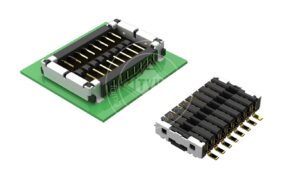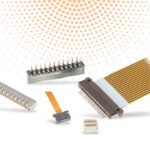Consumer Design Priorities Favor Connector Performance
Consumer connectivity helped drive miniaturization trends. Now R&D is focused on doing more within existing form factors. We talk to a supplier on the cutting edge of consumer design to learn what’s coming next.

Consumer design has been a key driver of the miniaturization of electronic components. Guided by Moore’s Law, the evolution of computing progressed rapidly from room-sized computers to bulky desktops to the wonderfully slim and portable laptop computers that transformed the way we work and learn. Each leap forward required smaller and faster internal components that would fit inside the shrinking form factors while scaling up power and performance. When the iPhone went into development, consumer technology took an exponential step into extreme miniaturization. The computer that could fit in one’s palm opened the door to portable, wearable, and even implantable digital technologies.
“Everything today is powered by smaller and smaller, lighter and lighter components. We have pushed consumer designs to the minimum possible size,” said Harry Huang, foreign sales manager for Tarng Yu Enterprise. “Today, miniaturization is no longer the priority for our customers. Laptops are probably at the size they will stay at. What’s happening right now is that they want connectors that maintain the same size while providing higher performance.”
Tarng Yu, a Taiwanese connector manufacturer, focuses heavily on research and development, and works closely with major consumer electronics companies to create the internal and external interconnects that support new designs for laptops, desktops, and other consumer devices. From his position, Huang can preview the next developments in consumer design and how they are influencing connector technology.
Tarng Yu recently released the TU 1504 connector. Why is this product significant?
You’ll notice on that connector, all the pins are not the same pitch range. There are four signal pins at a 1.0 mm pitch but the power pin is 1.5 mm. Back in the day, all the pins had the same pitch range, and they all had the same performance in terms of a power output. Today, we have to ask our customer, ‘OK for this connector, for this laptop, how many power pins do you need? What is the total power output?’ We specifically made those power pins to their request and the signal pins remain the same. This is a hybrid connector, where the power pin and the signal pin are different pitch ranges, and that helps us maintain the same size of the connector while providing a higher performance for the laptop.
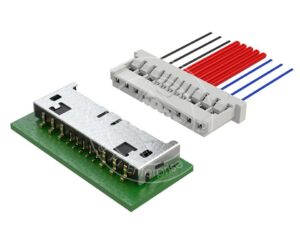
Tarng Yu’s TU1504 laptop battery pack connector provides increased performance in the same dimensional space as previous generation products.
Now that the form factor has been established you’re essentially fine-tuning the connector, but you still can find ways for the internal configuration to do more.
Exactly. A hybrid connector with signal pins and power pins at different pitch ranges allows us to do more with power. The connector size is as small as it will get, but the power output can be as high as 4.2 amps, 4.8 amps, or 5.2 amps, which is quite high for a really small connector. The connector has four to six power pins depending on pin configuration. That means that laptop can run about 10 to 15 amps of maximum current continuously, which is needed for higher-level equipment, such as gaming laptops.
Batteries are coming down in size as they increase in capacity. How does this affect battery connectors?
Two main design factors involve battery connections. One is changing the copper material. Right now, we use standard copper alloy for the power pins. But we’re in discussion with our suppliers and our customers, and for future generations we’re changing to high conductivity carbon alloy. So, without changing anything else, just changing the raw material, that performance can go higher. We’re playing with materials right now.
The second thing is the shell. The outer shell is stainless steel, and that shell also acts as a connected pin. This allows customer a new extra signal pin for additional function without changing the dimension of the connector.
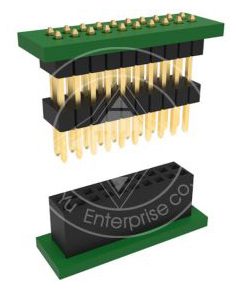
Tarng Yu connectors are designed with the same concept: Do more inside the same form factor.
Are you exploring new materials for shells?
Everything—pins, every component, every element of a component. We are playing with new materials in the power pin of the connector, just different types of copper alloy. We are trying to refine a few things: The conductivity, the hardness or softness,, and the oxidation factor of the copper material. Some copper alloys may have really high heat conductivity, but it may be more rigid, making it harder to form into shape during the stamping process.. With softer materials, the yield strength is lower which effects the total mating cycle and mating resistance. There is that fine balance between how soft or how hard the copper material must be and that is only one of the factors we need to consider in development.
When you are exploring new materials or bringing in more metal, what are the implications in terms of heat?
We can define the maximum current of a connector based on temperature rising. EIA-364 is our base standard for all our connectors, but for specific customers, they may require more rigid, more rigorous testing. This relates to heat. If we define the maximum current of a connector based on temperature rising (let’s say we have a connector that can withstand 5A current continuously), we run this current through the connector contact until temperature is stable. We measured the temperature before testing and again during testing. To certify for CUL standards, the temperature rise at the contact point cannot exceed 30 °C + 30 °C. If it exceeds that, then it’s considered in a dangerous zone and we cannot rate the current at that level. In terms of current and temperature, that’s the test standard. But in terms of the material itself, the scanner is always -40 °C+ 105 °C. More and more, our customers are asking if you have -40 °C and +125 °C. We can test our material to see if it can withstand those temperatures and provide the test report to our customers if they need it, but for the plastic raw material for the terminal, the metal terminal, and for the one harness, it’s all pretty standard to meet the industry spec of -40 °C and +105 °C or 125 °C.
R&D is a pretty important part of your business. Is that done in house or do you work with the testing lab?
We have 50 to 60 engineers in product design, mold design, auto-assembly machine design, and our own lab for testing three main scopes: electrical testing, environmental testing, and mechanical testing, which is mainly vibration, force, and drop testing. Those are just a few examples, and for environmental testing, there’s salt spray, humidity, temperature, extreme temperature testing, things like that. We have the equipment to test for UL and cUL standards, but we are not a certified testing lab for UL. We send it to a third party to test, but we test beforehand to make sure that the connector can pass.

Tarng Yu’s TU2019 laptop connector is ideal for consumer computing products.
When you’re dealing with consumer design, you’re basically dealing with a harsh environment, because people are so hard on their devices.
Yeah, people carry their laptops everywhere they go, so there’s a lot of harsh, mechanical-specific testing that we need to run through. We also make waterproof and industrial type connectors, and those are really rugged in terms of temperature, vibration, and humidity. Just to make sure that they all perform up to standard, having our own laboratory and having our own R&D team is quite important for initial design phase, quality control, production consistency, and just generally a competitive advantage.
What other trends do you see influencing connectors used in consumer devices?
The future industry standard for battery connectors for laptops may involve changes to the cables. Some of our customers are trying to use an FFC because it’s flat. It’s a bit more expensive, yes, but you can pack more in the same space.
Our TP1251 is also a laptop battery connector, but as you can see from the image, there is no cable. It is a board-to-board type connector. Because it’s an FFC-type connector, per pin can run up to 3A and this has 16 pins, so you can see how high the performance is with this connector. They can go up to 18 A max current for the laptop and with FFC-type cables it’s really compact, but the performance is really, really high.
Can that support performance in a gaming laptop, for instance?
Yes, yes.
As we see more AI and other higher level computing functions come into more common use, do you think the average laptop is going to need to have that gaming level of performance?
We do see that the general, even the most basic type of laptop, will have to have higher and higher levels of performance. AI and 5G and all that will demand more. We are already developing gaming type connectors and will be ready as they become more standardized in all consumer laptops. From a consumer point of view, most laptops do what most people need them to do.
They’re pretty amazing products, even compared to what was available just five years ago. What are you working on for connectors we’ll need five years from now?
Consumer designs—for laptops, e-bikes, even cars—don’t need as high of a speed as server, IPC type connectors, but they do need low high speed, meaning maybe 1 GB/s,10 GB/s, or maybe 20 GB/s for their application. We are developing new connectors for those low high-speed requirements. That’s what we’re seeing the industry running towards, where there’s two different types of connectors—low high speed and high speed. We are already in the high-speed connector industry (such as our SFF 8639, Gen Z, and DA-CEM), we’re trying to touch more on the low high speed for internal connectors.
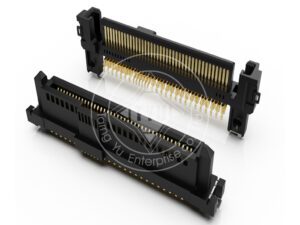
SAS PCIe 68PIN (SFF-8639) high-speed connector from Tarng Yu Enterprise Co Ltd.
What consumer trends are you following that will impact future connector design?
Let’s say you’re a laptop company and you have 10 different laptop models. You have high performance, standard, and lower performance ones. All those models have specific motherboard designs, specific battery types, and the connectors are unique. Back in the day, every model had a specific battery, a specific cable, and a specific connector. That made it really difficult to manage the supply chain. Now, what the industry is trying to do is develop a battery pack with the connector on the battery pack and a separate cable to connect to where they need to connect, maybe the motherboard. Then they could make every battery pack the same for every model, which makes things easier in terms of logistics and lower cost.The reason they’re all really high spec is because gaming or high-performance laptop connectors will be needed where commercial type connectors are used now. Right now, they are above performance for those laptops; the connector is over spec. But using them in place of commercial type connectors saves them a lot of time and logistics in terms of standardization and has them ready for when high performance is standard in more levels of laptops.
Visit Tarng Yu to learn more about cutting-edge connectors for consumer and other applications.
Like this article? Check out our other articles on Innovation and High-Speed, our Consumer Market Page, and our 2023 and 2024 Article Archives.
Subscribe to our weekly e-newsletters, follow us on LinkedIn, Twitter, and Facebook, and check out our eBook archives for more applicable, expert-informed connectivity content.
- Where in the World is Amphenol LTW’s Luc Kan? - April 23, 2024
- TE Connectivity’s Sustainability Efforts Pay Off - April 23, 2024
- What is a VGA Connector? - April 23, 2024
